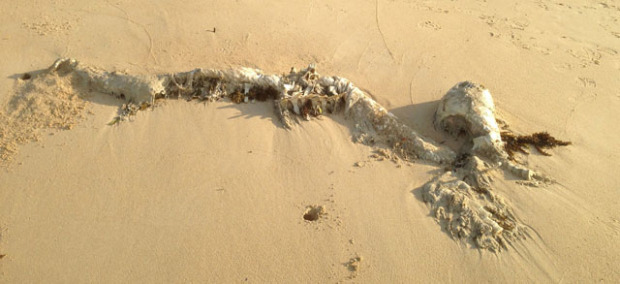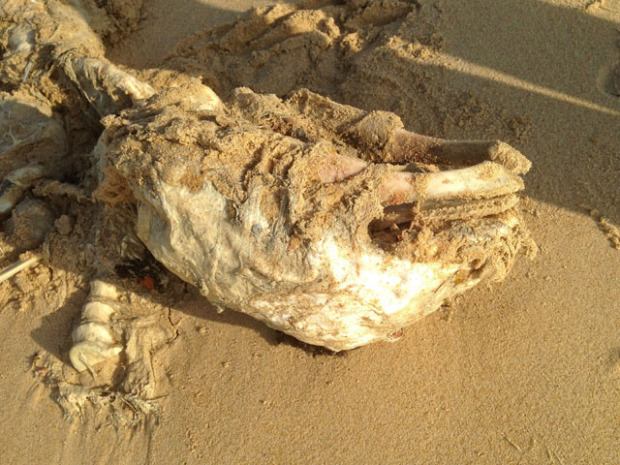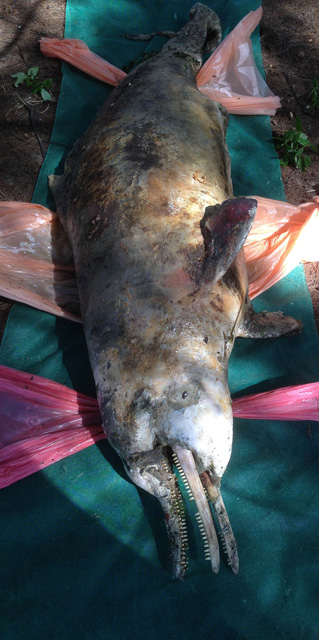News //
[Note: Images of decomposing carcasses are found in this post]
A carcass of an unidentified vertebrate washed up at East Coast Park (ECP) beach on 15 Jul 2014. A park user who noticed the remains notified NParks.
NParks staff verified the report and passed the message from the Parks division (Liew Qi) to the National Biodiversity Centre (Cheo Pei Rong), to the LKCNHM collections manager, Kelvin Lim, then to me. By now, it was being referred to as a cetacean carcass (dolphin or porpoise).


On the morning of 16 Jul 2014, I went down to ECP to check and retrieve the carcass. There, it was confirmed to be indeed a cetacean as the skull, flippers and tail fluke was visible, but in an advanced state of decomposition.


The decision was then made to retrieve the carcass. The body, which was almost as heavy as me, was bagged with the aid of two very helpful NParks staff, Tan Wen and Jan Tan (who was on her second week on the job).
As the carcass was too big to fit in a car, Department of Biological Sciences (DBS) graduate students, Maxine Mowe, Liew Jia Huan and Ng Ting Hui, helped by facilitating a pick up with the department’s vehicle from fieldwork at Marina Reservoir. Ting Hui kindly drove the carcass to the museum.

Back at the museum, the sense of excitement (it was a rare salvage after all) was enough to motivate the museum folk to brave the stench for a peek at the carcass while it was prepared for bone preservation by Kate Pocklington and myself. Some bits of tissue was frozen for the cryogenic collection. Kelvin quickly selected skulls from the Zoological Reference Collection as comparative material. The carcass was then identified to be an internationally threatened Irrawaddy dolphin (Orcaella brevirostris) measuring approximately 2.2 m. Tammy Lim and Kho Ziyi documented the process, and we all smelled like dead cetaceans at the end of the day.


But just when we thought that one dolphin carcass was rare enough, we were surprised that a second dolphin carcass washed up on ECP beach three days later. This was also reported by a member of the public, Mr Rajeshpal, and we identified it to be an Indo-Pacific humpback dolphin (Sousa chinensis). We were fortunate that we managed to recover the carcass with the help of NEA’s service provider (Ramky Cleantech Services – Ms Khng) and NParks (Liew Qi) with less fanfare as it was the weekend. There was no sign of external injury to the animal and the cause of death could not be determined.
Both skeletons will be deposited as specimens in the Zoological Reference Collection for research and education after cleaning. There are currently plans to have the skeleton of the Indo-Pacific humpback dolphin articulated for future display. Already, we are learning from both carcasses, which are the first confirmed specimens of their respective species in Singapore in recent years. More information is published in Singapore Biodiversity Records [1, 2]. News about the carcasses have also generated interest and awareness of dolphins in Singapore on social media.
In all, success in the recovery of both carcasses was not a case of coincidence. Awareness about the importance of carcass for science and education was championed over the years by former museum officer, Siva (now a lecturer at DBS). The initial standard operating procedures for carcass reporting and retrieval was also established by Siva and Kelvin. NParks has also helped to put in place a well-oiled process of carcass reporting within the organisation.
We would like to take this opportunity thank everyone who helped with the carcass recovery, especially NParks, NEA/Ramky Cleantech Services and ACRES.
Although we prefer seeing our wild animal alive, dead animals are important for science and education. Salvage operations like this one help us to learn more about biodiversity in Singapore.
What to do if you if you encounter a wild animal carcass:
1. Contact ACRES 24-hour hotline at 9783 7782.
2. Or report it to us at https://lkcnhm.nus.edu.sg/our-research/dead-wildlife-reporting-in-singapore/ or email mammal@sivasothi.com (all information goes to the same established database).
A description, photographs and information about the specific location of the carcass would be most useful.